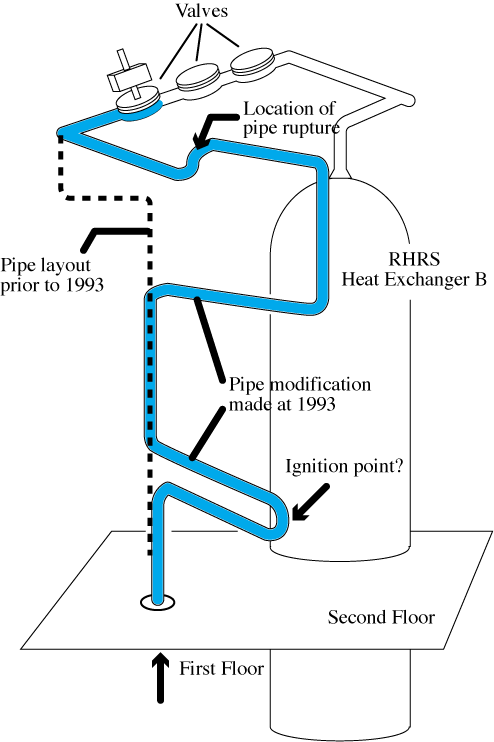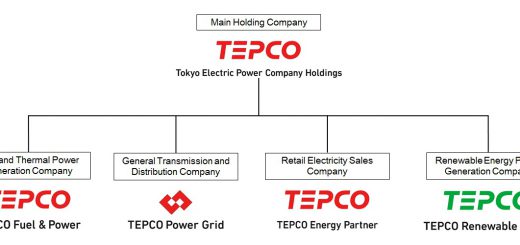Insufficient Investigation: Hydrogen Explosion and Water Leak at Hamaoka 1 Nuke Info Tokyo No. 90
The Reports on 1 Submitted
On April 24, Chubu Electric Power Company submitted a final report to the Ministry of Economy, Trade, and Industry (METI) regarding the two accidents at Hamaoka 1 in November 2001 (see related articles in NIT 87 & 88). The report summarizes the investigations of the cause and the reoccurrence prevention measures for both; the Residual Heat Removal System (RHRS) pipe rupture and the water leak from the Control Rod Drive (CRD) housing portion of the reactor pressure vessel.
The final report concludes with the mechanism of the cause of the two accidents as follows.
In the pipe rupture accident, hydrogen and oxygen were generated in the RHRS pipe due to radiolysis of reactor coolant in the pressure vessel, and then accumulated in a high concentration in the pipe. When a pressure spike was made by the periodical manual startup test operation of the High Pressure Coolant Injection (HPCI) system, the pressure fluctuation in the pipe led to an ignition followed by the detonation. The report explains that noble metals (Pt and Rh), used to prevent stress corrosion of the lower part of the reactor containment vessel, might have been involved in the detonation.
As for the water leakage accident from the bottom of the pressure vessel, it was thought that the stress – which was supposedly made when the CRD Housing was welded to the pressure vessel – would have caused the corrosion crack.
Figure 1: RHRS pipe modification made at 1993

Following the report by Chubu Electric Power Company, both the Nuclear and Industrial Safety Agency (NISA) in METI and the Nuclear Safety Commission (NSC) issued investigation reports on May 13 and May 23 respectively, which confirmed the content of the report and the analysis conducted by Chubu Electric Power Company.
Rushed Work and Ensuing Accident
None of the reports conducted scientifically sound analysis or adequately clarified the cause of the accidents. This gives an impression that the report was hastily written to put an end to the matter of the accidents at Hamaoka-1 and to mitigate adverse reactions in regard to other nuclear plants. On May 24, the day after all the government reports were issued, Chubu Electric Power Company started the operation of Hamaoka-2. However, much bustling activity at the company resulted when the operation was shut down due to a water leak from a drainpipe of the Low Pressure Coolant Injection (LPCI) system. The accident at Hamaoka-2 reveals the superficial nature of the report and the inadequacy of Chubu Electric’s investigation.
Causes of the Pipe Rupture Remain Unclear
In regard to the pipe rupture accident, Chubu Electric Power Company and Toshiba Corporation – the plant manufacturers – have conducted accident reproducibility experiments and analyzed the results, assuming the scenario of the accident.
The experiments include: 1) a gas accumulation test to check whether a gaseous layer of hydrogen and oxygen and a steam layer are generated; 2) a pressure fluctuation test to check whether start-up of the HPCI pump and opening the valve will feed high temperature steam into the gaseous layer; and 3) an ignition test to check with the inflow of the steam would ignite to hydrogen and oxygen.
In the experimental test, the data suggests reproducibility of the event, with the gases becoming stratified and accumulated, and steam entering the gaseous layer upon the opening of the HPCI valve. However, the main steam temperature in a Boiling Water Reactor (BWR) only reaches 290oC. It is considered that the steam temperature must be more than 350oC for the ignition of hydrogen and oxygen under the pressure of the 6 to 7 MPa in the pipe. The scenario, assuming the ignition was caused by the heat supply from the steam inflow, is insufficient to explain this accident.
During the test, the ignition was confirmed in only four cases out of 104 trials. In each of the four cases, platinum and rhodium were added at considerably higher concentrations (approximately ten to hundred times more) than the ones detected on the inside surface of the ruptured pipe at Hamaoka Unit-1. As a result of this experiment, the report concluded that noble metals are probably related to the ignition in the pipe.
At the startup of the periodical investigation at Hamaoka Unit-1 two years ago, a noble metal chemical addition was implemented to prevent stress corrosion cracks in the reactor pressure vessel and structures inside the vessel (Figure 2). This measure was taken to complement the hydrogen water chemistry in the coolant, which had been executed prior to the investigation. The noble metals detected in the ruptured pipe were the same as those leaked from the valve when the RHRS B pump was started up during the noble metal chemical addition.
It is not clear how the noble metals remained in the pipes. Were they adhering to the inside surface of the pipes, or were they in any gaseous forms? In any case, even though the noble metals could accelerate the reaction velocity of hydrogen and oxygen, it is hard to believe that they acted to reduce the ignition temperature by tens of degrees. Are there any factors connected to the ignition that have not been covered in the scenario?
The direct cause of the ignition was not specified in the final report. The report points out that one of the possibile causes was due to the alteration work on the pipe in 1993. As for the leakage prevention measure of the RHRS branch valve, the pipe was altered and made crooked so that the coolant was stored in the upper part of the valve. It is obvious that this alteration enabled hydrogen and oxygen to remain in the pipe. As a prevention measure for Hamaoka-1, Chubu Electric Power Company decided that they would remove the steam condensing pipes in the RHRS, and install valves where hydrogen will likely be accumulated.
On June 13, NISA announced a plan devised by all 20 electric companies to obviate the risk of a hydrogen explosion accident at 20 BWRs: Hamaoka 1 and 2; Onagawa 1, 2, and 3; Fukushima I 1, 4, and 6; Fukushima II 1, 2, 3, and 4; Kashiwazaki-Kariwa 1, 2, 3, 5, 6, and 7; Shimane 1; and Tsuruga 1. This measure was implemented in accordance with NISA’s call for the additional investigation of the pipes other than steam condensing pipes. The plan includes the installation of bent pipes (exhaust pipes) and the modification of the pipe layout during the periodical investigation (some of the modifications are currently being introduced).
Water Leak Check to be Continued
On June 19, NISA also demanded that there should be further inspection and investigation of the accident at Hamaoka in which a crack appeared and a leak was discovered in the stub-tube of the control rod drive housing. June 19 is the date marked for this work. This inspection will be made with a view to ensuring safety at power plants which employ the same materials and welding methods as the Hamaoka BWR unit. Those include five BWR type reactors: Onagawa 1, Fukushima I 6, Fukushima II 1 and 3, and Kashiwazaki-Kariwa 1. The visual inspection of the penetration portion of the CRD Housing will be performed during periodical inspections using an underwater camera after nuclear fuel is removed from the reactor vessel by 2004.
By Chihiro Kamisawa

